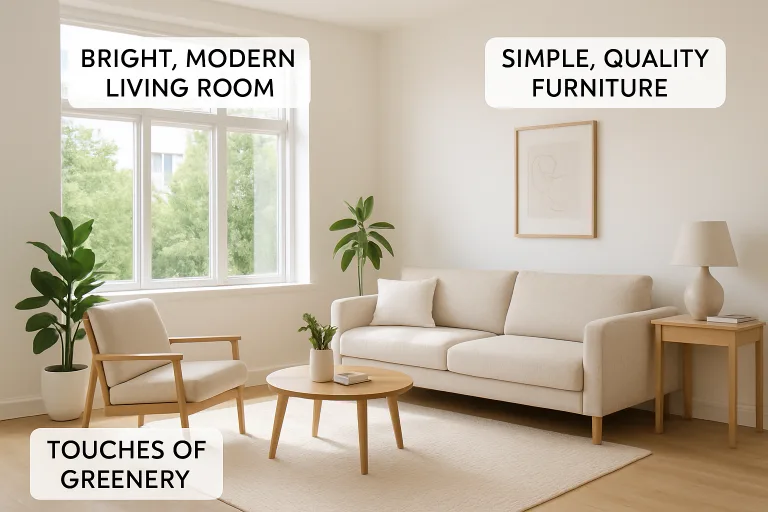Maintaining Elegant Design in Modern Real Estate Spaces

Key Takeaways
- Elegant design is achievable in both new developments and historical homes.
- Balancing functional needs with aesthetics is essential for modern living.
- Research shows that thoughtfully designed spaces have a measurable impact on well-being.
- Simple updates can have a significant effect on the mood and usability of any room.
Table of Contents
- Balancing Function and Beauty: Why It Matters
- Choose Quality Over Quantity
- Natural Light Makes a Difference
- Personalization in Design
- Timeless Materials and Finishes
- Designing for Well-Being
- Maintaining Style in Different Room Types
- Industry Trends to Watch
- Conclusion
Balancing Function and Beauty: Why It Matters
An elegantly designed home is not just about eye-catching style—it’s about seamlessly integrating both function and visual appeal. Today’s real estate market, especially in highly attractive communities like Bellingham, increasingly values spaces that support both work and leisure. Expert guidance, such as that provided by Bellingham WA real estate experts Julian & Company, centers on creating harmonious interiors that cater to unique lifestyles while ensuring every square foot is thoughtfully utilized. Function and beauty are two sides of the same coin. Deliberate design choices, from classic floor plans to innovative open concepts, shape a home’s look and how it feels to live in each day. Designing with both in mind elevates everyday living, creating spaces that are as comfortable as they are visually appealing.
Choose Quality Over Quantity
The secret to a truly elegant interior lies in making intentional choices. Less is almost always more when it comes to furnishing a modern home. Opting for fewer, higher-quality items—such as a well-crafted sofa or timeless dining table—brings clarity and sophistication to a room, while minimizing clutter and waste. This approach is recommended by leading designers who cite its long-term benefits for sustainability and lasting visual appeal. By focusing on investment pieces with enduring style, homeowners also find it easier to keep spaces fresh without falling into the trap of relentless trend-chasing. This philosophy works equally well in new builds and historic residences, ensuring that elegance remains at the forefront even as individual tastes evolve.
Natural Light Makes a Difference
Harnessing natural light transforms rooms, enhancing both style and livability. Large windows, sheer draperies, and mirrored or glossy surfaces amplify daylight—enriching the color palette, improving mood, and creating a sense of openness. Consistent exposure to natural light supports better mood and mental clarity, making this a non-negotiable aspect of modern home design. Even subtle updates—like a strategic furniture rearrangement or lighter wall colors—can coax new brilliance from existing windows, proving that elegant updates aren’t reserved for full-scale renovations.
Personalization in Design
The difference between a house and a truly elegant home often comes down to personalization. Layering in curated artwork, cherished keepsakes, or bespoke textiles fosters a space that feels deeply individual and inviting. Balanced with restraint, these touches prevent a space from feeling generic or sterile. Designers recommend integrating color schemes and feature pieces that tell your story, allowing even the most classic backdrop to feel current and lived in. A personalized space resonates more deeply with both residents and guests, transforming elegance into a dynamic and relatable experience.
Timeless Materials and Finishes
Materials such as marble, oak, and brushed metals stand as enduring pillars of elegant design. These elements bridge the gap between historic charm and contemporary simplicity, adapting fluidly to changing styles and tastes. Upgrading kitchens with natural stone or incorporating walnut cabinetry ensures a style that resists obsolescence. Beyond beauty, timeless finishes also enhance property value, making them a smart inclusion for those seeking to balance style with investment. With proper maintenance, they age gracefully, underscoring the importance of thoughtful selection for lasting elegance.
Designing for Well-Being
There is mounting evidence that rooms designed for comfort and serenity also promote mental and physical wellness. Features like hidden storage, peaceful hues, and natural elements like indoor plants support a calming environment. The concept of biophilic design—incorporating nature into interiors—continues to rise in popularity, backed by studies linking it to improved mood and reduced stress. Design for well-being isn’t a luxury; it’s fast becoming a fundamental expectation as more people are conscious of the connection between their environment and their health.
Maintaining Style in Different Room Types
Every room in a home performs a distinct function, and style should reflect these needs. Bedrooms should evoke relaxation, with gentle lighting and soothing textures, while kitchens benefit from practical layouts and durable surfaces. Marked transitions between spaces can disrupt the sense of flow—meaning the most elegant homes weave unifying design elements throughout, even as they adapt to each room’s role. This holistic approach, as championed by many modern designers, ensures continuity, comfort, and beauty in every corner of the home.
Industry Trends to Watch
Current trends in real estate and interior design highlight sustainability, minimalist aesthetics, and flexible living solutions. Adaptation to these shifts is essential, as homeowners seek both style and substance. Industry authorities regularly showcase inventive approaches that marry responsible choices with modern sensibility. These trends reflect broader lifestyle changes and technological advancements, making continual adaptation key to maintaining relevance and elegance in today’s homes.
Conclusion
Elegant design in the modern era is defined by intentionality, balance, and enduring quality. Whether renovating a historic treasure or moving into a new build, the core principles remain: seek harmony between function and form, invest in quality, bathe spaces in natural light, and personalize each room. With mindful, well-informed choices, homeowners can craft inviting, sophisticated environments that thrive through shifting trends and evolving needs.
